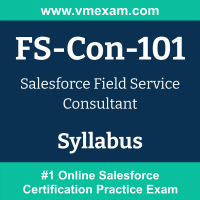 The Salesforce FS-Con-101 exam preparation guide is designed to provide candidates with necessary information about the Field Service Consultant exam. It includes exam summary, sample questions, practice test, objectives and ways to interpret the exam objectives to enable candidates to assess the types of questions-answers that may be asked during the Salesforce Certified Field Service Consultant exam.
The Salesforce FS-Con-101 exam preparation guide is designed to provide candidates with necessary information about the Field Service Consultant exam. It includes exam summary, sample questions, practice test, objectives and ways to interpret the exam objectives to enable candidates to assess the types of questions-answers that may be asked during the Salesforce Certified Field Service Consultant exam.
It is recommended for all the candidates to refer the FS-Con-101 objectives and sample questions provided in this preparation guide. The Salesforce Field Service Consultant certification is mainly targeted to the candidates who want to build their career in Salesforce Consultant domain and demonstrate their expertise. We suggest you to use practice exam listed in this cert guide to get used to with exam environment and identify the knowledge areas where you need more work prior to taking the actual Salesforce Field Service Consultant exam.
Salesforce FS-Con-101 Exam Summary:
|
Exam Name
|
Salesforce Field Service Consultant |
| Exam Code | FS-Con-101 |
| Exam Price |
Registration fee: USD 200 Retake fee: USD 100 |
| Duration | 105 minutes |
| Number of Questions | 65 |
| Passing Score | 63% |
| Recommended Training / Books |
Prepare for your Salesforce Field Service Consultant Credential Implement Salesforce Field Service (FSL201) |
| Schedule Exam |
Kryterion Webassessor PEARSON VUE |
| Sample Questions | Salesforce FS-Con-101 Sample Questions |
| Recommended Practice | Salesforce Certified Field Service Consultant Practice Test |
Salesforce Field Service Consultant Syllabus:
| Section | Objectives | Weight |
|---|---|---|
| Managing Resources |
- Set up and manage crews. - Determine how and when to set up different resource types. - Given a scenario, recommend the appropriate Service Territories and their Members. - Explain the relationships between time sheets, time sheet entries, service resources, and Work Orders. - Demonstrate how to use skills, skill levels, and time-based skills. - Show how to use operating hours for service resources, accounts, work orders, and booking appointments. - Distinguish between field service license types and when to deploy them. |
16% |
| Managing Work Orders |
- Configure Work Order processes, parameters, and Work Types. - Given a scenario, choose the appropriate Resource Preferences. - Apply Products Required to a Work Order. - Analyze how and when to use Work Order Line Items. - Illustrate how to configure Work Order Milestones. - Given a scenario, recommend the appropriate relationship between Service Appointments, Work Orders, and Work Order Line Items. |
23% |
| Managing Scheduling and Optimization |
- Understand different field service settings for SFS Administrator. - Given a scenario, choose the appropriate action to manage a Service Appointment. - Given a scenario, apply the appropriate lifecycle of a Service Appointment required to execute a Work Order. - Decide on the appropriate Schedule Policy to achieve the business requirements. - Given a scenario, determine the appropriate option to execute Complex Work in SFS. - Explain the difference between a multi-day Service Appointment and a standard Service Appointment. - Outline the differences between aerial versus street-level routing. - Given a scenario, determine the appropriate dispatch strategy for an organization. - Compare different filtering options for the Dispatcher Console. - Explain how to set up optimization. - Given a scenario, decide the appropriate type of scheduling service to use. - Given a scenario, decide the appropriate type of optimization service to use. - Understand the usage of Salesforce Field Service for DateTime tracking fields. |
28% |
| Configuring Mobility |
- Assess the requirements and tools needed to execute a customer sign-off process. - Given a scenario, configure the Field Service app to support key business processes. - Distinguish between Field Service Mobile and Salesforce Mobile app capabilities. - Understand the available SFS Mobile settings. |
10% |
| Managing Inventory |
- Given business requirements, distinguish the appropriate price book model for products consumed. - Given business requirements, justify which define the applicable inventory model. - Explain the Return Order object model and process. |
8% |
| Managing Assets | - Apply procedural concepts to maintain and update assets and asset relationships. | 5% |
| Configuring Maintenance Plans | - Given a scenario, recommend the appropriate maintenance plan. | 5% |
| Permissions and Sharing |
- Understand use cases for different types of SFS permission sets. - Explain how scheduled Service Appointments are shared with service resources. - Understand the differences between user territories and service territories. |
5% |
